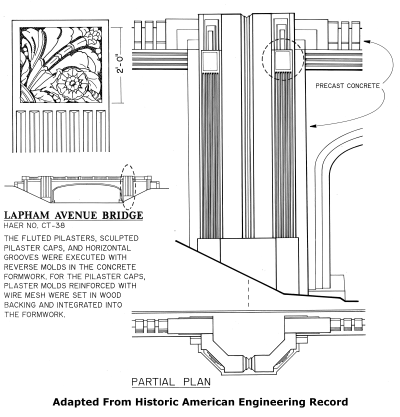We Recommend:
Bach Steel - Experts at historic truss bridge restoration.
BridgeHunter.com Phase 1 is released to the public! - Visit Now
Lapham Road Bridge

Primary Photographer(s): Nathan Holth and Rick McOmber
Bridge Documented: July 13, 2008
New Canaan: Fairfield County, Connecticut: United States
1989
62.0 Feet (18.9 Meters)
73.2 Feet (22.3 Meters)
30 Feet (9.14 Meters)
1 Main Span(s)
5810

View Information About HSR Ratings
Bridge Documentation
View Archived National Bridge Inventory Report - Has Additional Details and Evaluation
View Historic American Engineering Record (HAER) Documentation For This Bridge
HAER Data Pages, PDF - HAER Original Plan Sheets, PDF
View Historic American Engineering Record (HAER) Documentation For The Merritt Parkway
HAER Drawings, PDF - HAER Drawings, High Resolution PDF - HAER Data Pages, PDF

About The Bridge
The historic bridge superstructure which once stood here has been demolished and replaced with a pre-stressed slab of concrete. Pictured on this website is the replacement structure. It is standard HistoricBridges.org policy to never include modern bridges within the website, however an exception was made with this Merritt Parkway Bridge because the facade placed on the outside of the bridge nearly replicates the architecture of the original bridge superstructure, although there are some discrepancies. In addition, the bridge's substructure (abutments) may contain original parts and materials, although more research is needed to confirm. Original substructures alone are insufficient for any structure to be considered a historic bridge, however. This non-historic pre-stressed concrete slab/beam bridge has no heritage value. It is imperative that future bridge work on the remaining historic Merritt Parkway Bridges not include demolition and replacement and instead focus on preservation techniques such as routine maintenance and structural rehabilitation. As for this particular bridge, assuming the abutments are original, suggested preservation work would be to remove the pre-stressed concrete superstructure from the bridge and replicate a concrete rigid-frame superstructure from the original historic bridge structural plans.
Please refer to the Historic American Engineering Record (HAER) documentation of the original historic bridge for further information on the demolished historic bridge.
The name Lapham is the name of a wealthy individual who lived in New Canaan. He was influential enough that the reason the Merritt Parkway curves away from New Canaan in this area is because Lewis B. Lapham, and eventually his heirs who inherited the land in 1934, demanded it do so to avoid an ancient oak tree on his property.
About The Merritt Parkway
The Merritt Parkway, the first divided limited access highway in Connecticut, is one of the most unique and historically significant highways in the United States. The roadway was designed to combine the beauty of a parkway with the function of a limited access highway. As such, it is an early example of a limited access highway, and a unique example of one which also includes aesthetics as a major design consideration. This design consideration is no more clear than it is with the bridges of the Merritt Parkway. Each bridge is unique, with no two bridges identical. While some other early parkways and limited access highways included aesthetic design in their bridges, the Merritt Parkway stands out as a large, complete, and well-preserved example. In addition, its bridges display a far wider diversity in design and aesthetic treatment from bridge to bridge than other similar roadways which the Merritt Parkway might be compared to. A large number of the bridges on the Merritt Parkway remain today well-preserved and not demolished. However it is true that some bridges have been demolished and replaced, some mimicking the original bridge's design, and others do not.
HistoricBridges.org Merritt Parkway Bridge Documentation
In 2008, HistoricBridges.org traveled the Merritt Parkway
and using a high-speed DSLR camera, collected a series of elevation overview
photos of a large portion of the historic Merritt Parkway overpass bridges,
taken from a moving car. Time constraints did not allow for a full
photo-documentation of the bridges. As such, only a handful of photos for
each bridge is currently available on this website. These photos help
document the historic Merritt Parkway as a whole, and provide a framework
for a full photo-documentation of the Merritt Parkway Bridges in the future,
and also compliment the existing Historic American Engineering Record (HAER)
documentation for the Merritt Parkway and its bridges. HAER has already
completed an extensive documentation which includes measured drawings of the
bridges and a massive 100+ page historical narrative, all contained within
HAER's Merritt Parkway page. The link is available above. In addition, HAER
also completed individual documentation for many of the bridge structures on
the Merritt Parkway.
This bridge is tagged with the following special condition(s): Merritt
![]()
Photo Galleries and Videos: Lapham Road Bridge
Bridge Photo-Documentation
Original / Full Size PhotosA collection of overview and detail photos. This gallery offers photos in the highest available resolution and file size in a touch-friendly popup viewer.
Alternatively, Browse Without Using Viewer
![]()
Bridge Photo-Documentation
Mobile Optimized PhotosA collection of overview and detail photos. This gallery features data-friendly, fast-loading photos in a touch-friendly popup viewer.
Alternatively, Browse Without Using Viewer
![]()
Maps and Links: Lapham Road Bridge
Coordinates (Latitude, Longitude):
Search For Additional Bridge Listings:
Bridgehunter.com: View listed bridges within 0.5 miles (0.8 kilometers) of this bridge.
Bridgehunter.com: View listed bridges within 10 miles (16 kilometers) of this bridge.
Additional Maps:
Google Streetview (If Available)
GeoHack (Additional Links and Coordinates)
Apple Maps (Via DuckDuckGo Search)
Apple Maps (Apple devices only)
Android: Open Location In Your Map or GPS App
Flickr Gallery (Find Nearby Photos)
Wikimedia Commons (Find Nearby Photos)
Directions Via Sygic For Android
Directions Via Sygic For iOS and Android Dolphin Browser
USGS National Map (United States Only)
Historical USGS Topo Maps (United States Only)
Historic Aerials (United States Only)
CalTopo Maps (United States Only)


